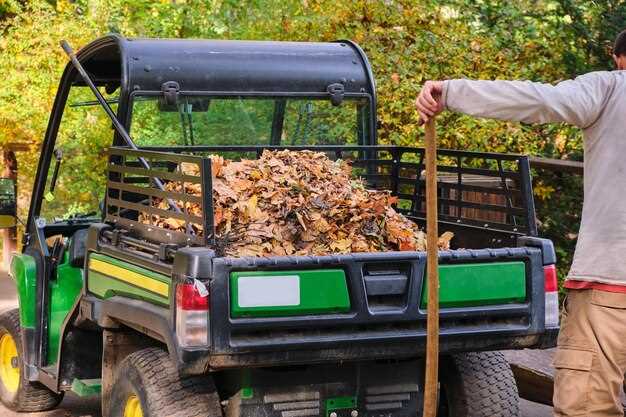
As the leaves begin to change and fall, homeowners are faced with the essential task of preparing their yards for the winter months. This season marks the perfect time for yard cleanup and maintenance, and utilizing a trailer can significantly streamline these efforts. Whether you are hauling away bags of leaves, branches, or other debris, having a utility trailer at your disposal can make the process more efficient and less labor-intensive.
A utility trailer provides ample space and versatility for transporting large volumes of waste materials. Its design makes it ideal for hauling everything from lawn clippings to heavy tree branches, ensuring that your yard is not only tidy but also promotes a healthy environment for your plants to thrive. By using a trailer, you can save time and energy that would otherwise be spent on multiple trips to the dump or compost site.
Incorporating a trailer into your fall yard maintenance routine not only simplifies hauling tasks but also allows you to tackle more significant projects, like tree pruning or fence repairs, with ease. As you prepare your yard for the colder months, consider how a utility trailer can enhance your efficiency and make fall cleanup a breeze.
Choosing the Right Trailer for Yard Cleanup Tasks
When it comes to hauling debris, leaves, and other materials during the fall, selecting the appropriate trailer is essential for efficient yard cleanup. The right trailer not only enhances the speed of your work but also ensures that you can handle various types of waste effectively.
First, consider the size of the trailer. A larger trailer can accommodate more debris, minimizing the number of trips required to transport yard waste. However, ensure that your vehicle can handle the weight and size of the trailer; compatibility is crucial for safe hauling.
Next, examine the type of trailer that best suits your needs. For fall yard cleanup, a utility trailer with high sides can be particularly useful. This design allows for easy loading and prevents materials from spilling during transport. Additionally, trailers with ramps facilitate the loading of heavier items like bags of leaves, branches, or yard equipment.
Another factor to consider is the trailer’s construction material. Steel trailers are durable and can handle heavy loads, while aluminum trailers are lighter, making them easier to tow and maneuver. Assess your typical hauling needs to find a balance between weight and durability that works for your yard maintenance tasks.
Finally, check for features such as removable sides, tie-down points, and weather-resistant covers. These elements can greatly enhance the functionality of the trailer, making it easier to manage fall cleanup efficiently. With the right trailer, yard cleanup can transform from a daunting task into a straightforward, manageable chore, allowing you to enjoy the beauty of the fall season without the stress of unused debris.
Safety Tips for Hauling Debris and Yard Waste

When it comes to cleaning up your yard in the fall, using a utility trailer can make the hauling of debris and yard waste more efficient. However, safety should always be a priority. Here are some essential safety tips to consider when hauling your yard waste.
- Choose the Right Trailer: Ensure your utility trailer is suitable for the type and amount of debris you plan to haul. Check the weight capacity to avoid overloading.
- Secure Your Load: Always secure debris properly. Use tie-down straps, ropes, or nets to prevent items from shifting or falling off during transport.
- Distribute Weight Evenly: Place heavier items towards the front of the trailer and distribute weight evenly to maintain stability while driving.
- Wear Protective Gear: Equip yourself with gloves, a mask, and safety goggles when handling yard waste to protect against sharp objects and allergens.
- Check Your Vehicle: Ensure your vehicle is capable of towing the trailer safely. Check brakes, lights, and tires before hitting the road.
By following these safety tips, you can ensure a smooth and incident-free experience while hauling debris and yard waste with your utility trailer. Always prioritize safety to make yard cleanup a successful endeavor.
Best Practices for Organizing and Loading Your Trailer

Efficiently organizing and loading your trailer is essential for effective fall yard cleanup and maintenance. Proper preparation ensures that all necessary tools and materials are easily accessible, making the hauling process smoother.
First, plan your load. Before you start loading your trailer, make a list of items you’ll need for your fall cleanup, including rakes, tarps, bags, and any yard debris. This helps in determining how to efficiently utilize the available space.
Next, prioritize items. Load heavier and bulkier items, such as bags of mulch or heavy garden tools, towards the front of the trailer. This helps maintain stability while hauling. Lighter items, like rakes and brooms, can be placed on top or at the rear.
Utilizing storage solutions can maximize your trailer space. Consider investing in toolboxes or storage bins that can hold smaller items, keeping them organized and secure during transport. This prevents items from shifting and creates a cleaner loading experience.
Avoid overloading your trailer, as exceeding weight limits can compromise safety. Always check your trailer’s capacity before loading. If you’re hauling a significant amount of yard waste or debris, make multiple trips if necessary.
Secure your load properly to prevent shifting during transportation. Use straps or bungee cords to fasten items in place, ensuring they remain intact throughout your journey. This not only protects your tools but also enhances safety on the road.
Regular maintenance of your trailer is also crucial. Before starting your fall cleanup, inspect tires, brakes, and lights to ensure everything is in working order. A well-maintained trailer is more efficient and safer for hauling equipment and yard waste.
By following these best practices, you’ll be well-equipped to tackle your fall yard cleanup efficiently, making the most of your trailer’s capacity and functionality.





